Author’s note: For an updated tasting that featured 13 whiskey/rum barrel aged wines check out the post Whiskey and Wine Revisited.
As I’ve admitted before, I can be a bit skeptical about newfangled wine trends but I always try to keep an open mind. So when I walk into stores and see big displays of Gallo’s Apothic Inferno (“A Wine With a Whiskey Soul” they say) supported with advertising campaigns featuring tatted up and vested hipster bartenders playing with fire, I know I need to try some wines aged in bourbon and whiskey barrels.
![By Ken Thomas (KenThomas.us (personal website of photographer)) [Public domain], via Wikimedia Commons](https://upload.wikimedia.org/wikipedia/commons/e/ea/Woodford_Reserve_Distillery-27527-5.jpg)
I love Woodford Reserve in my Old Fashioned, not necessarily in my wine.
Henry H. Work’s 2014 book Wood, Whiskey and Wine gives a nice backstory on the love affair between wine and wood barrels that extend over two millenniums. He also goes into the sharing of barrel technology with other beverages like whiskeys and beers. I highly encourage folks interested in geeking out more about this topic to give it a look.
Wood, Whiskey and Wine gives a nice backstory on the love affair between wine and wood barrels that extend over two millenniums. He also goes into the sharing of barrel technology with other beverages like whiskeys and beers. I highly encourage folks interested in geeking out more about this topic to give it a look.
In the 17th century, the convenience and availability of excess Sherry barrels from the bustling Jerez to London trade led to a “happy accident” of Scotch makers discovering the rich dark fruit flavors and deeper color that Oloroso Sherry barrels impart on whiskey aged in them.
In recent decades, the concept of cask-finishing for whiskeys has expanded to include barrels that previously housed Port, Madeira, Sauternes, Amarone and even First Growth Bordeaux and premium Super Tuscan and Barolo producers.
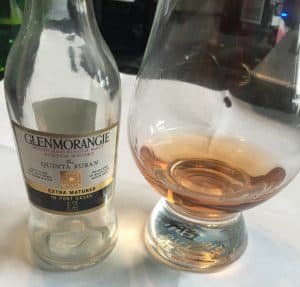
A Port finished Scotch from one of my favorite distilleries
Across the pond, American Bourbon and whiskey producers also discovered the interesting flavors and added complexity of aging in former wine barrels. Of course, Sherry and Port casks were popular choices but producers also branched out with California Chardonnay like Woodford Reserve’s Sonoma-Cutrer finish. Even winemakers started getting in on the gig, like Dave Phinney’s partnership with a distillery to create a Bourbon aged in barrels that formerly held his Orin Swift Napa Cabernet Mercury Head. (Not sure what the status of this project is after Phinney’s sale of Orin Swift to Gallo)
Whiskey Returns the Favor (maybe)
Perhaps taking a cue from the beer industry which has seen a huge explosion in popularity of barrel-aged beer, it may have been inevitable that we would see wine aged in whiskey barrels.
The first mentioned of a whiskey barrel aged wine that I could find was back in 2010 when a winemaker in Australia some how got his hands on Pappy Van Winkle Barrels to age his 2008 McLaren Vale Shiraz. What became of his Southern Belle Shiraz, or if you can still find it, I don’t know as there are scant tasting notes on the web. I do find it interesting that the 2010 article from Garden and Gun noted that the expected release price for the 2008 was $25 USD but the average price of the three vintages available on Wine-Searcher (2009, 2011 & 2013) is only $9. If any one has further details about this wine (or know of an earlier whiskey barrel-aged wine), let me know in the comments below.
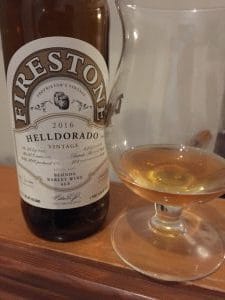
A very tasty barrel aged brew from Firestone Walker
As with most things in the wine industry, people usually don’t start paying attention to a trend until the big-money players get involved and that is what happened in 2016 when
Pernod-Ricard (Jacob’s Creek),
Constellation Brands (Robert Mondavi),
Concha y Toro (Fetzer) and
E. & J. Gallo (Apothic) released their whiskey barrel-aged wines.
Are these wines any good?
I was able to get my hands on 3 brands of whiskey barrel-aged wines–Robert Mondavi Bourbon Barrel Aged Cabernet Sauvignon, Barrelhouse Bourbon Red (made by Bruce and Kim Cunningham of AW Direct) and Apothic Inferno (aged in whiskey instead of Bourbon barrels). Tasting these wines with colleagues in the retail wine industry, I wanted to be as objective as possible so we decided to do this tasting blind and with a “ringer” of a popular dark red blend (which was the most recent hot trend in the industry till the whiskey-aged wines came barreling in). In this case, I chose Cloud Break Black Cloud from O’Neil Vintners.
Here are my notes before the reveal:
Wine A- Sweet smelling on the nose. Very ruby port-like nose with figs and dark fruit. Some vanilla.
On the palate, rich fruit, very smooth but with noticeable RS. Yep, definitely very port-like with more overt oak spice flavors on the palate. Medium acidity. Medium-minus tannins.
My guess is that this is one of the bourbon barrels one. Drinkable, good for sweet(ish) red wine drinkers. Actually this may be an improvement over many of the “Dark” blends since the oak spice seems to add some complexity.
Wine B-This smells like a whiskey. But whiskey that smells like burnt rubber. Noticeably sweet nose. Roasted marshmallows and burnt flambe cherries. It smells like someone took a shot of cheap lightly peated whiskey, mixed with a really pungent Pinotage and then added it to someone’s Seagram 7 and Coke.
On the palate, Burnt rubber and roasted marshmallows. Medium-minus tannins and medium-minus acidity, maybe even low acidity. It’s no where near as sweet as I expected it to be based on the nose but I can’t tell if that is a positive or negative at this point.
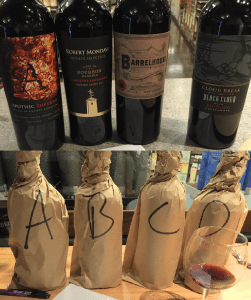
Three whiskey barrel aged reds with a “regular” red blend ringer. (Not wrapped up in the same order. See reveal below)
Much more subdued nose, medium-minus intensity but that may just be a scale down effect compared to Bag B. I don’t really smell any oak at all, just some subtle red fruit–red berries, maybe a little red plums.
On the palate, I can get some vanilla but it is still very mellow. Medium+plus acidity, actually has some good life to it. Definitely still red fruit. Medium tannins, very ripe and smooth.
My gut is telling me that this is the regular red blend but I’m a bit confused with the fruit being much more red than dark, knowing in the back of my mind that the “ringer” is one of the Dark Red styles. Whatever this is, its fairly enjoyable and with the medium plus acidity, can actually see this being a decent drinker and food pairing option.
Wine D- Medium nose. Still way more subdued than Bag B and less fragrant than Bag A. Much more overt vanilla on the nose. This has a bit of a “whiskeyness” to it but its not in your face. A little dark fruit but, again, subdued.
On the palate, this has some great texture. Medium+ acidity. Medium + tannins but very velvety and great full body. By far the most impressive mouthfeel. This feels like a decent $15-17 Cab. The flavors are very Cab-like as well, being more black currant with a little tobacco spice. The finish lingers with the vanilla and I do almost feel like I can taste a bit of roasted corn. Not enough to be weird but at this point I’m wondering if my palate is shot.
The Reveal and Final Thoughts
Bag A.) Cloud Break Black Cloud — (The Dark Red blend “ringer”) I was totally fooled on this. The ruby-port aspect had me thinking that THIS is what these Bourbon barrel-aged wines should taste like. Definitely a wine for the smooth, bold (but slightly sweet) red crowd. 3rd favorite of the group.
Bag B.) Apothic Inferno – As you could probably infer from my notes, this was my least favorite wine of the bunch. It certainly had the most in your face “whiskeyness” but, in my opinion, that didn’t add up to a pleasurable drinking experience in the slightest. Personally, I would rather drink any of the other examples in the Apothic stable (the regular red, Apothic Dark, Apothic Crush, etc) than the Inferno. It’s just not my style of wine at all.
Bag C.) Barrelhouse Bourbon Red – This pleasantly surprised me. It definitely wasn’t what I expected from this category. As I noted, I strongly thought this was just a regular red blend. Very solid and very drinkable. Probably the 2nd best of the whole bunch.
Bag D.) Robert Mondavi Bourbon Barrel Age Cabernet Sauvignon – the clear winner of the group and a very solid wine. I don’t think this wine needs the marketing gimmick of the “bourbon barrel age” (neither does the Barrelhouse really) and could easily stand on its own as regular, every day drinker that would do well paired with food or at a party with a crowd.
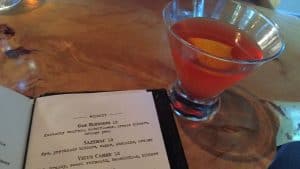
Or we can just drink some cocktails instead. The Oak Blossom was delicious!
So there you have it. It’s worth having an open mind and I would encourage all wine drinkers to give these wines a try and form their own opinions.
Some of these wines, like the Robert Mondavi Cabernet Sauvignon and Barrelhouse Bourbon Red, are pretty solid and legit red wines. Others…..do have their own unique personality. I definitely recommend trying these wines side by side with either other whiskey barrel-aged wines or just general red blends. That is, by far, the best way to judge the character of these wines and see how they stake up against what you enjoy in red wine.
Cheers!

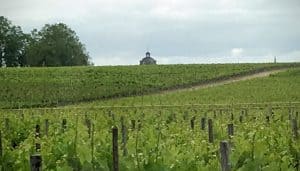
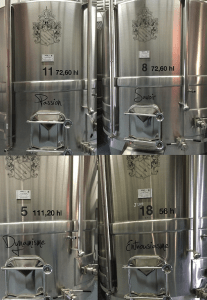
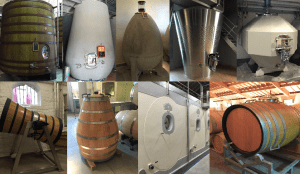

![By Ken Thomas (KenThomas.us (personal website of photographer)) [Public domain], via Wikimedia Commons](https://upload.wikimedia.org/wikipedia/commons/e/ea/Woodford_Reserve_Distillery-27527-5.jpg)



